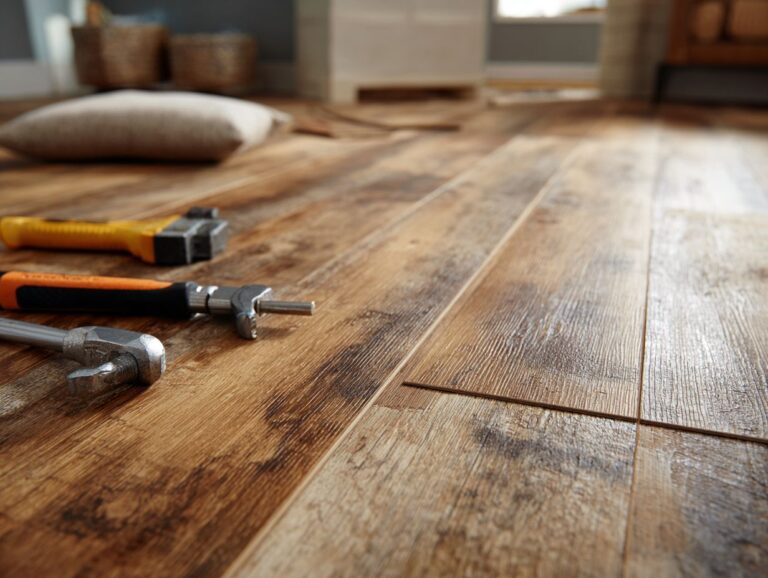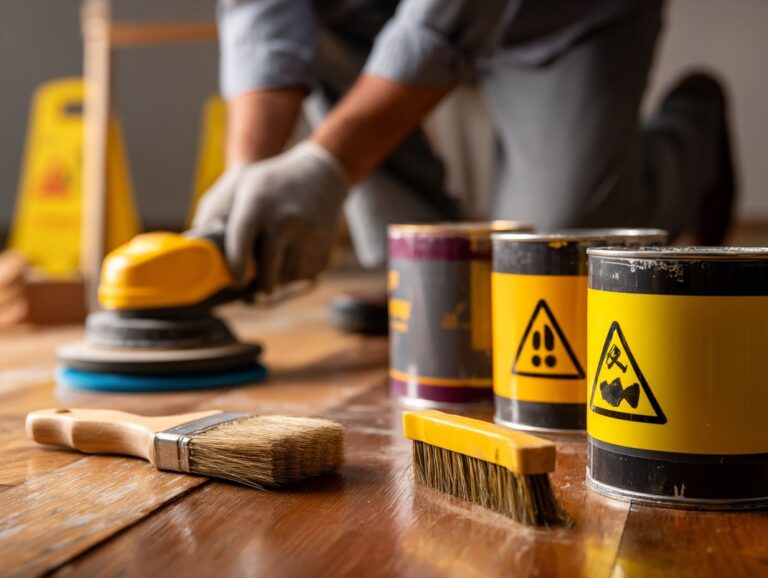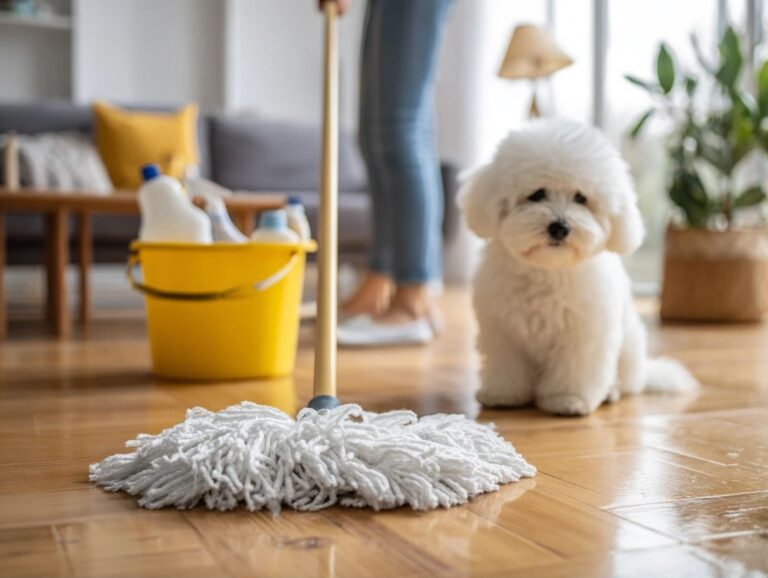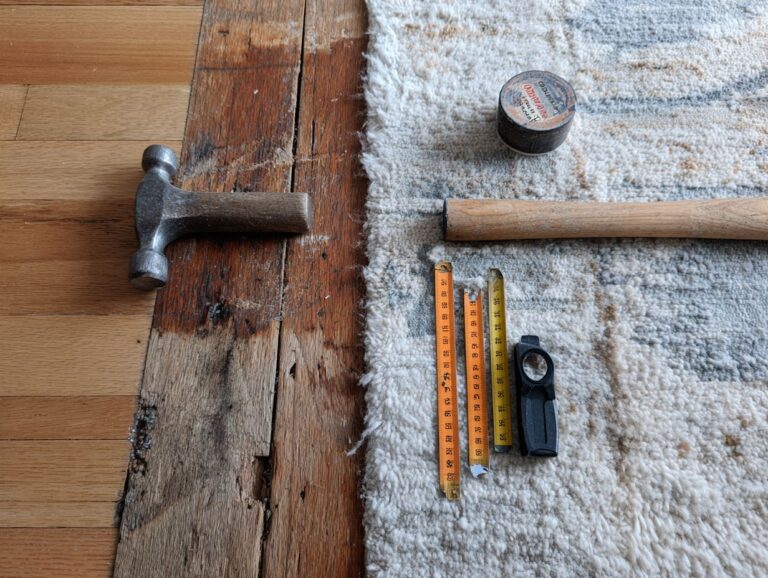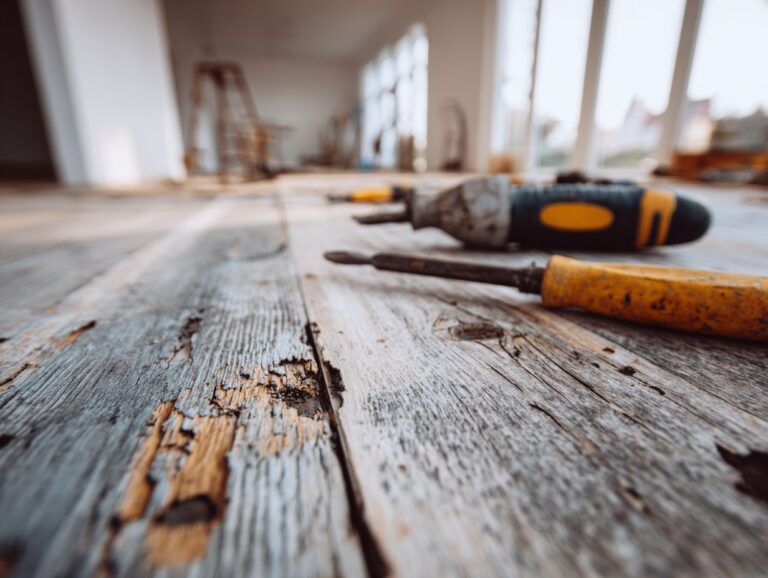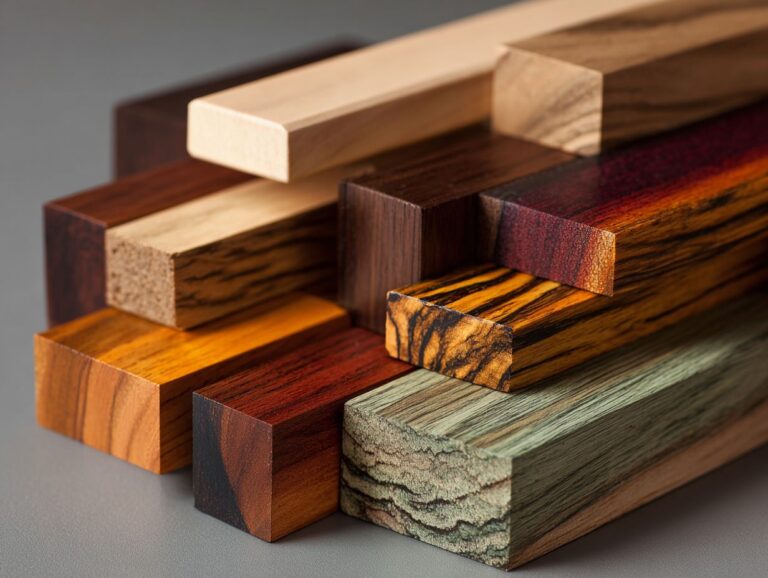Garage Flooring Options – Beyond Basic Concrete
Changing your garage floor from plain concrete to a trendy and practical area is simpler than you might expect. While a plain concrete floor offers durability, options like stained concrete, epoxy paint, and concrete sealers provide versatility and aesthetic appeal. This article discusses new garage flooring choices that make your garage look better and last longer while being easier to take care of. Learn how to improve your garage with useful ideas and advice from professionals!
Key Takeaways:
Contents
- Garage Flooring Market Statistics
- Epoxy Flooring
- Polyurethane Flooring
- Interlocking Tiles
- Vinyl Flooring
- Rubber Flooring
- Concrete Staining and Sealing
- Frequently Asked Questions
- What are some garage flooring options beyond basic concrete?
- What are the benefits of using tiles for garage flooring?
- Is epoxy coating a good choice for garage flooring?
- Are rubber mats a good option for garage flooring?
- What are the advantages of interlocking PVC floor tiles?
- Can garage flooring options beyond basic concrete be customized?
Importance of Choosing the Right Flooring
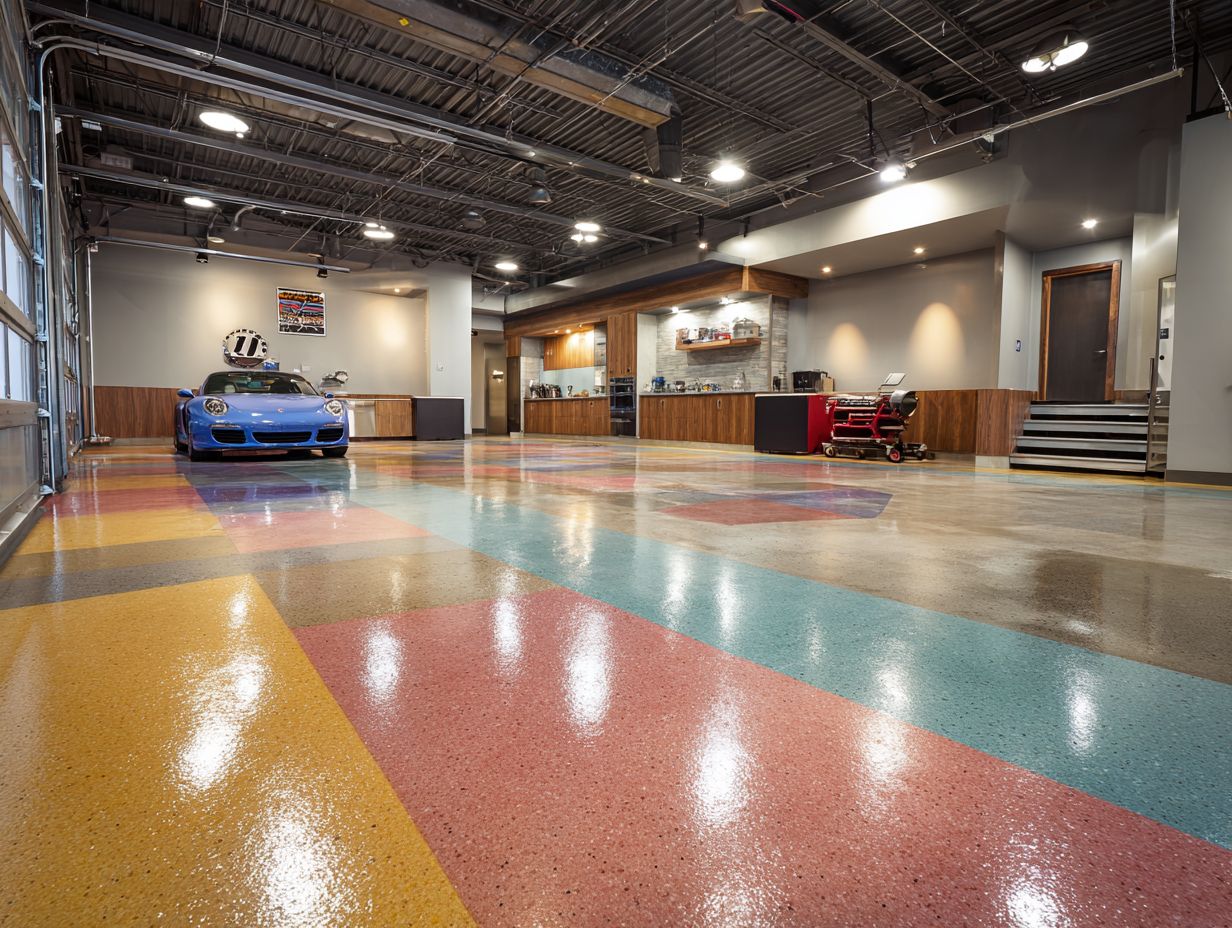
Choosing the best garage flooring can make it last longer and be easier to clean, turning your garage into a more useful area.
For example, epoxy flooring is renowned for its durability and resistance to stains, reducing cleaning time by up to 50%. Interlocking rubber tiles offer a strong grip and can be easily swapped out if they get damaged, which makes them a favorite for DIY enthusiasts.
Polished concrete provides a sleek finish that requires minimal upkeep. When choosing, consider the specific activities in your garage; if you work on cars, prioritize resistance to oil and chemicals.
Investing in the right flooring can significantly cut maintenance costs in the long run.
Garage Flooring Market Statistics
Garage Flooring Market Statistics
Market Growth and Revenue: Global Market Revenue Growth
The Garage Flooring Market Statistics The dataset gives a detailed look at how the market is growing and changes in different areas. The market size is projected to grow significantly, from $28.8 billion in 2021 to an impressive $76.6 billion by 2033, showing a strong yearly growth rate of 8.5% from 2025 to 2033. More people want garage flooring because of the rise in home improvement projects and more people owning cars.
Analyzing the Regional Market Shares for 2025, North America holds the largest market share at 34.84% This shows the area’s strong buying power and their liking for home improvement products. Europe follows closely with a share of 29.32%, supported by a growing emphasis on residential property aesthetics. The Asia Pacific region, with a share of 24.31%, showcases rapid urbanization and rising disposable incomes, driving market expansion. South America and the Middle East make up smaller portions, with 9.27% and 6.52%, respectively, indicating emerging opportunities in these markets.
Delving into Country Market Shares within Regions for 2025, the United States dominates North America with a staggering 76.26% share, highlighting its significant influence and consumer base. In comparison, Canada and Mexico hold shares of 15.11% and 8.63%, respectively, showing growth potential. Germany leads in Europe with 22.22%, while China commands a major portion in Asia Pacific at 38.14%, driven by industrialization and housing developments. In South America, Brazil holds a notable 37.84%, and Turkey contributes 15.38% within the Middle East, indicating key areas for targeted market strategies.
The data collectively illustrates the garage flooring market’s expansion, fueled by regional economic factors and consumer preferences. This information is important for businesses looking to take advantage of growth opportunities and plan their market entry or expansion in certain regions and countries.
Overview of Options Beyond Concrete
While bare concrete remains common, options like stained concrete, epoxy paint, and roll-out vinyl are gaining popularity for their aesthetic and protective qualities.
Stained concrete offers a wide range of colors and finishes, enhancing the visual appeal of outdoor spaces while remaining affordable. In contrast, epoxy paint is highly durable, providing a seamless, moisture-resistant surface that’s perfect for garages or basements.
Vinyl mats that can be easily unrolled are simple to install and available in various patterns, making them suitable for high-traffic areas.
These options improve appearance and protect the concrete, making them suitable for homes and businesses.
Epoxy Flooring
Epoxy flooring provides a strong option for garage areas, appreciated for its durability and attractive appearance.
Benefits of Epoxy Flooring
One main benefit of epoxy flooring is that it resists water, making it an excellent option for garages where spills or moisture are frequent.
Epoxy flooring exhibits high durability, resisting stains and wear from heavy foot traffic or machinery. It’s easy to keep it clean; just wash it with soap and water to maintain its appearance.
With a variety of finishes available-such as glossy or matte-you can customize your space according to your style. Epoxy is a good investment because it can last over 10 years.
Its reflective surface makes the room brighter, which can help lower electricity costs.
Installation Process
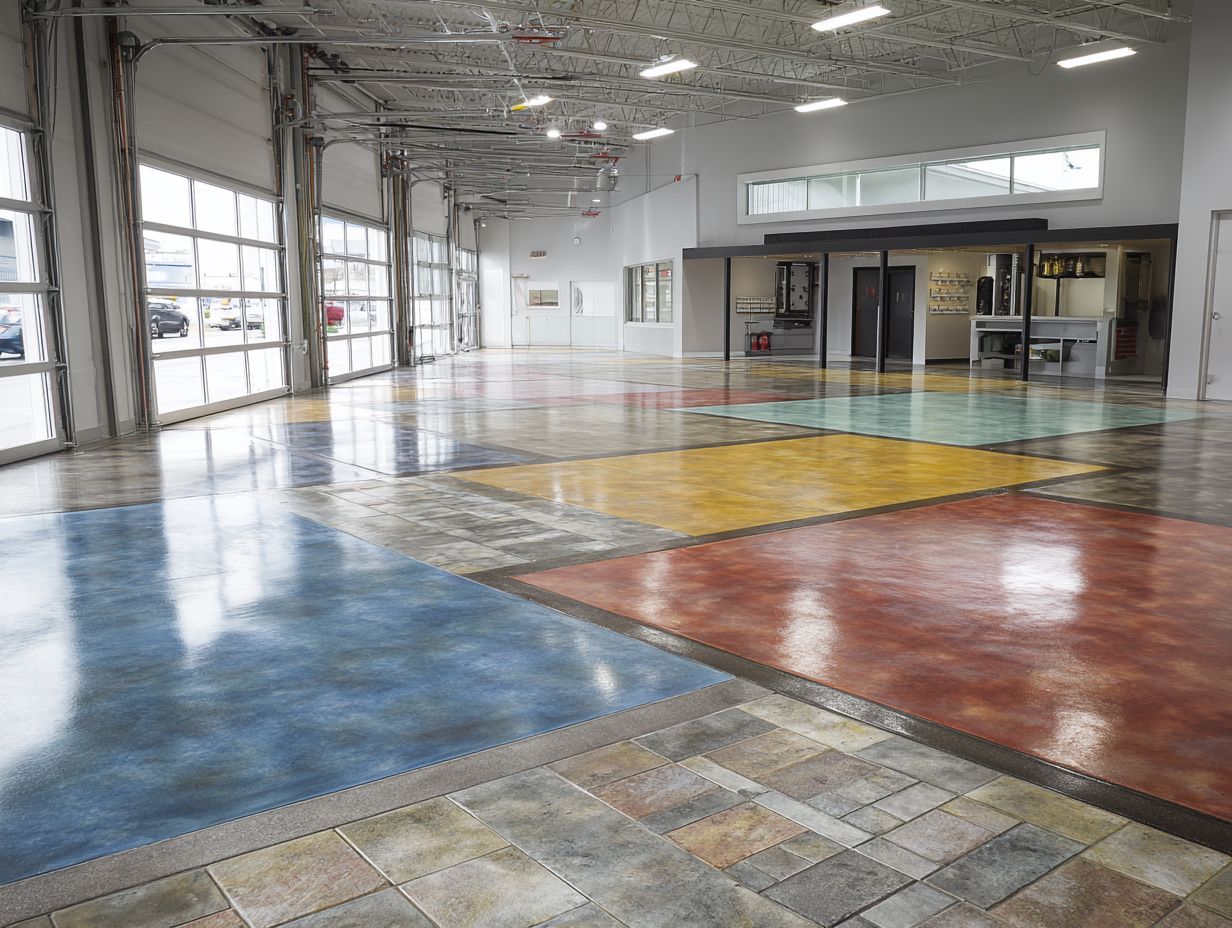
Installing epoxy flooring typically requires a 3-step process: surface preparation, mixing the epoxy, and applying the coating.
- Start by carefully cleaning the concrete surface to get rid of dirt, grease, and cracks.
- Use a concrete grinder for a smooth finish, which usually takes 1-2 hours.
- Next, mix the epoxy resin with the hardener as directed-typically a 1:1 ratio. This step takes about 30 minutes.
- Use a roller to spread the epoxy over big sections and a squeegee to evenly spread it in corners.
- Allow it to cure for at least 24 hours before walking on the surface, achieving a durable and attractive finish.
Maintenance and Durability
With proper care, epoxy flooring can last up to 10 years, requiring minimal maintenance to keep it looking new.
To keep your epoxy floor in good condition, use these simple steps:
- First, regularly sweep and mop with a mixture of warm water and a few drops of diluted vinegar to remove dirt without damaging the finish.
- Second, avoid harsh chemicals that can dull the surface; stick to gentle cleaners specifically designed for epoxy.
- Look for any damage or signs of wear each month, and address minor issues immediately to avoid costly repairs.
- Placing floor mats in high-traffic areas can significantly extend the lifespan of your flooring, keeping it pristine for years.
Polyurethane Flooring
Polyurethane flooring is a great option instead of epoxy. It has special advantages that make it good for certain garage uses.
Advantages Over Epoxy
Polyurethane flooring has better UV protection than epoxy, which makes it a good choice for garages that get a lot of sunlight.
Plus UV stability, polyurethane flooring offers excellent flexibility, which helps it resist cracking under heavy loads, a key benefit for garages storing vehicles.
Its chemical resistance safeguards against spills from automotive products, enhancing longevity and maintaining aesthetics.
For installation, consider using tools like a trowel for smoothing and a roller for even application. Make sure the surface is ready by cleaning it and ensuring the concrete is even. This will help the material stick better, usually setting completely over a weekend to create a strong finish.
Application Techniques
Putting down polyurethane flooring can be easy, especially for DIY fans who have the proper tools.
To begin, prepare the concrete by cleaning and patching any imperfections.
Next, mix the polyurethane components as per the manufacturer’s instructions. Using a roller, apply the mixture evenly across the surface, ensuring there are no bubbles or streaks.
Polyurethane usually dries quickly, unlike epoxy which takes hours and needs a more complicated two-part mix. This means you can finish your work in one day. This efficiency makes it a favorable option for quick flooring updates.
Long-term Care and Maintenance
Long-term care for polyurethane flooring involves simple maintenance routines that help preserve its aesthetic appeal and functionality.
To maintain your polyurethane floors, use gentle cleaners like Bona Hardwood Floor Cleaner, which is pH-balanced and non-toxic. Avoid ammonia and harsh chemicals that can strip the finish.
Cleaning spills immediately with a soft cloth prevents staining, while regular dust-mopping minimizes scratches. Consider using a protective coating like Minwax Polycrylic every 2-3 years to restore shine and durability.
Setting a cleaning schedule can keep your floors looking pristine and extend their lifespan significantly.
Interlocking Tiles
Interlocking tiles provide a flexible and easy-to-install flooring choice that can improve the appearance and use of any garage.
Types of Interlocking Tiles
Interlocking tiles come in various materials such as vinyl, rubber, and even porcelain, each with unique benefits for garage use.
Vinyl interlocking tiles are popular for their ease of cleaning and affordability, typically priced between $2-$4 per square foot.
Rubber tiles are popular because they absorb impacts well and last a long time. They are great for areas with heavy equipment and usually cost between $3 and $7 per square foot.
Porcelain tiles offer a premium look and impressive stain resistance but come at a higher cost, usually $5-$10 per square foot.
Consider your budget and intended use when choosing the right material, as each type caters to specific functional needs.
Installation Benefits
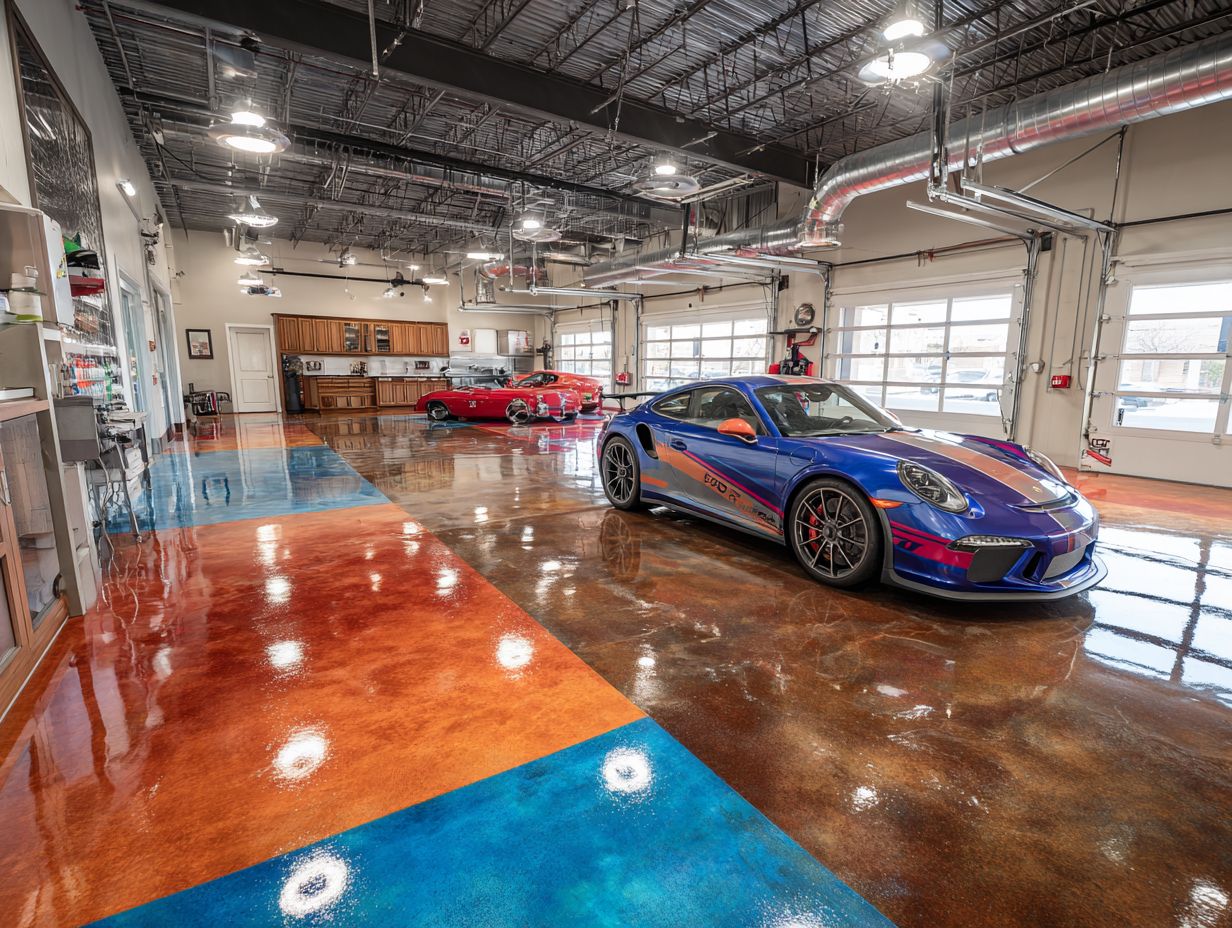
A big benefit of interlocking tiles is that they are easy to install and usually don’t need glue.
This ease of installation allows you to complete a standard garage flooring project in as little as 4 to 6 hours.
Just begin by getting your surface ready-make sure it’s clean and dry. Next, lay out the tiles from one corner to another, fitting them snugly together. If needed, use a utility knife to trim tiles along the edges for a perfect fit.
You can replace any damaged tiles individually without having to redo the entire floor, which makes maintenance easy.
Design Flexibility
Interlocking tiles allow for creative design possibilities, enabling homeowners to customize the garage appearance according to personal style.
One effective design approach is to mix and match colors for striking patterns. For example, combining grey and black tiles can create a sleek, modern look, while blue and white tiles may instill a nautical theme.
Creating separate areas, like a work space with strong tiles apart from the car parking area, improves how the space is used. Consider using textured tiles for added visual interest; brands like GarageTrac offer unique surface options.
Trying out these features can turn a regular garage into a customized area.
Vinyl Flooring
Vinyl flooring is a budget-friendly option for homeowners who want strong and attractive floors without spending a lot.
Characteristics of Vinyl Flooring
Vinyl flooring is well-known for being water-resistant and long-lasting, which makes it a great option for garages where spills and stains can occur.
Plus its protective features, vinyl flooring offers a variety of designs that can mimic the appearance of hardwood or tile, enhancing the overall aesthetic of your garage.
To set it up, you might need tools like a knife for cutting, a ruler to measure accurately, and a roller to smooth out seams. These tools facilitate a smooth and professional finish.
Vinyl flooring is comfortable underfoot, which can help lessen fatigue during extended activities, making it suitable for work and leisure.
Cost-Effectiveness
With an average cost of $1.50 to $3.50 per square foot, vinyl flooring stands out as one of the most budget-friendly options for garage upgrades.
Vinyl flooring is affordable, durable, and easy to keep clean, which makes it a good choice for garages.
For example, brands like TrafficMaster provide waterproof options that prevent stains and are more durable.
Installing vinyl can be a DIY project; simply measure your garage, prepare the surface, and use adhesive or interlocking tiles for a seamless finish.
By using a utility knife and a roller, a 20×20 garage can be completed within a day, resulting in a professional look for under $1,000, including materials.
Installation Options
Vinyl flooring offers various installation methods, including peel-and-stick tiles and full glue-down options, catering to different skill levels.
For peel-and-stick installation, simply clean and prepare the subfloor, then peel off the backing and press the tiles down. This method typically takes 1-2 hours for a small room and requires just a utility knife and measuring tape.
In contrast, the glue-down method involves applying adhesive to the subfloor before laying down the vinyl, ensuring a more secure fit but requiring 2-4 hours and tools like a trowel, roller, and possibly a substitute weight.
Choose the installation method that aligns with your DIY confidence and the flooring area’s size.
Rubber Flooring
Rubber flooring is now a common option for garages because it is very durable and absorbs impact well.
Benefits of Rubber Flooring
Rubber flooring is great for absorbing impact and is very durable, which makes it perfect for demanding use.
Rubber flooring works well in gyms, kitchens, and play areas.
-
For gym settings, its slip-resistant surface reduces accidents during workouts, while its durability withstands heavy equipment.
-
In kitchens, it offers easy cleaning after spills, ensuring a hygienic environment.
-
For children’s play areas, its shock-absorbing properties protect against falls.
Brands like Rubber-Cal and Interlocking Mats provide eco-friendly options, further enhancing their appeal to environmentally conscious users.
The choice of rubber flooring should fit the exact purpose and use needed.
Ideal Uses in Garages
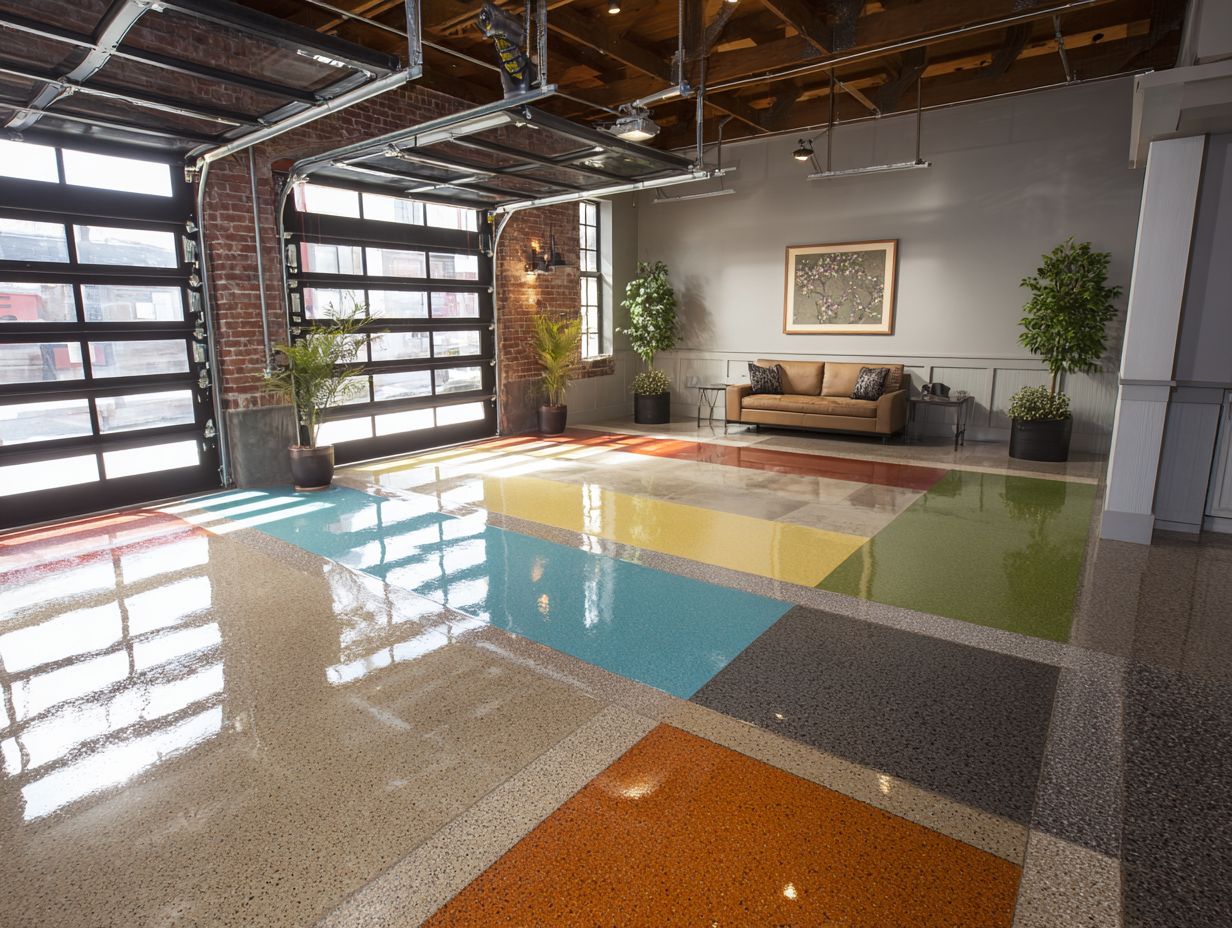
Rubber flooring is particularly suited for garages used as workshops or exercise areas due to its resilience and safety features.
This flooring material offers excellent shock absorption, reducing the impact on joints during workouts or heavy machinery use.
For a home gym, consider interlocking rubber tiles, which are easy to install and customizable in size.
In a workshop, continuous rolls can offer a smoother look and better resistance to spills, scratches, and heavy tools.
Successful installations often report reduced fatigue and increased safety, enabling enthusiasts and professionals to focus on their tasks without distraction.
Concrete Staining and Sealing
Staining and sealing concrete can improve and protect plain concrete surfaces, making them practical and attractive. To explore additional enhancements, consider the various concrete flooring options such as polished, stained, and stamped techniques that expand both functionality and aesthetic appeal.
Staining Techniques
Using different staining methods can greatly change the appearance of concrete floors and offer necessary protection.
-
Three well-known methods include acid staining, which adds deep and varied colors to concrete, usually costing between $0.50 to $2.00 per square foot.
-
Water-based stains are an environmentally friendly alternative that offers a wide range of colors, usually priced around $1.00 to $3.00 per square foot.
-
Decorative staining allows for the creation of unique patterns, though costs can vary significantly based on design complexity, generally ranging from $2.00 to $5.00 per square foot.
For those who enjoy DIY projects, make sure to get the surface ready and stick to the application instructions for optimal results.
Sealing Options
Selecting the correct concrete sealer is important for guarding against moisture and stains, extending the floor’s life.
Acrylic sealers provide a shiny look and work well on decorative surfaces. However, these need to be applied again every year and cost from $30 to $60 per gallon.
Epoxy sealers, priced from $80 to $120 per gallon, provide strong protection and last a long time, making them ideal for places where people walk a lot. However, they can be hard to use because mixing them is complex.
Polyaspartic coatings cure quickly and resist harsh chemicals, usually costing about $100-$150 per gallon.
Think about what you need before choosing, as each option works best for different situations.
Frequently Asked Questions
What are some garage flooring options beyond basic concrete?
Some options include tiles, epoxy coatings, rubber mats, and interlocking PVC floor tiles.
What are the benefits of using tiles for garage flooring?
Tiles are easy to install and come in a variety of materials, colors, and patterns. They are also resistant to stains, water, and chemicals.
Is epoxy coating a good choice for garage flooring?
Epoxy coating is a popular option for its durability, resistance to stains and chemicals, and ability to hide imperfections in the concrete surface.
Are rubber mats a good option for garage flooring?
Rubber mats are great for their cushioning effect and slip-resistant properties. They are also easy to clean and provide a comfortable surface for standing and working on.
What are the advantages of interlocking PVC floor tiles?
Interlocking PVC floor tiles are easy to install without the need for adhesives or special tools. They are also durable, slip-resistant, and can withstand heavy weight and vehicle traffic.
Can garage flooring options beyond basic concrete be customized?
Yes, many of these options can be customized with different colors, patterns, and even logos. This lets you create a one-of-a-kind and customized appearance for your garage.
